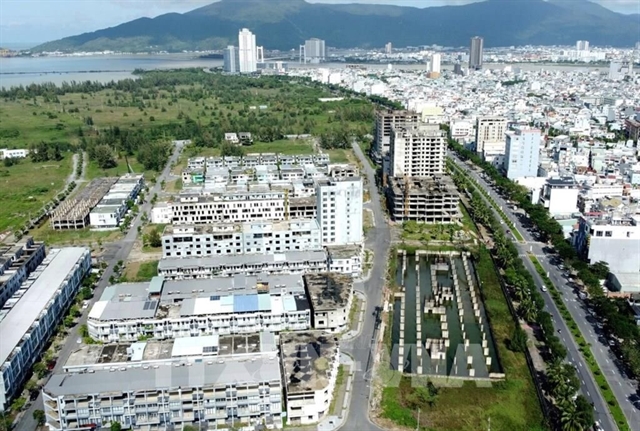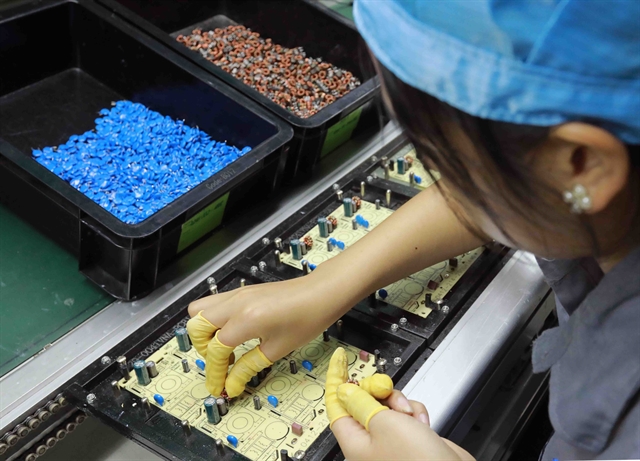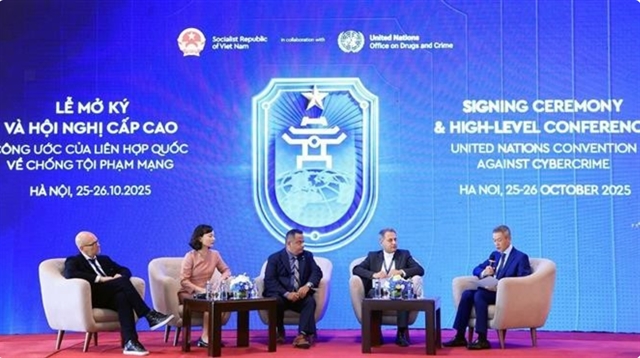 Business Beat
Business Beat

Compiled by Mai Linh

|
| Electronics components produced at a foreign-invested company in Hải Phòng City.. Việt Nam arises to be a star in attracting FDI. — VNA/VNS Photo Vũ SInh |
HÀ NỘI — Việt Nam was seeing a new wave of foreign investment, fuelled by an improved investment climate, upgraded infrastructure system, high-quality human resources, and leveraged diplomatic relations with major economies.
Nikkei Asia recently wrote that a fourth boom of foreign investment in Việt Nam might be in the making, led by the capital influx from the US after US President Joe Biden’s visit to Việt Nam last month.
Following the meeting between President Biden and General Party Secretary Nguyễn Phúc Trọng, Việt Nam and the US announced the establishment of a comprehensive strategic partnership.
After Biden’s visit, Vietnamese Prime Minister Phạm Minh Chính held a 6-day visit to the US, during which Chính visited the headquarters of Nvidia in San Francisco, calling on the chipmaking giant to establish a production base in Việt Nam.
Chính also worked with leading corporations of the US, including Microsoft, Meta, SpaceX, Coca-Cola, and Pacifico Energy, to promote investments in prioritised sectors such as manufacturing, technology, renewable energy, aviation, and innovation, as Việt Nam was aiming to pivot from its traditional labour-intensive industries.
According to Nikkei’s analysis, Việt Nam witnessed three significant booms in foreign capital influx. The first boom occurred in 1997 when Japan’s Honda Motor began local two-wheeler production, 10 years after Việt Nam passed the Law on Foreign Investment.
The second boom spanned the period from the early 2000s up to the time around the global financial crisis in 2008 with a notable investment of South Korea’s Samsung Electronics in a mobile phone production base in Bắc Ninh. The third was believed to have come into full swing in the mid-2010s.
“Now Biden's visit may trigger a surge in American investment in Việt Nam… Biden's diplomatic move may be interpreted by American businesses as a green light to invest in Việt Nam,” Nikkei wrote.
In late March, more than 50 US enterprises, led by the US–ASEAN Business Council, visited Việt Nam to study and seek investment and business cooperation opportunities.
On Wednesday last week, the US-headquartered Amkor Technology, a global leader in the outsourced semiconductor assembly and test industry, which also operates in the Republic of Korea, opened a $1.6 billion semiconductor manufacturing plant covering 23 hectares in Bắc Ninh Province.
Receiving Vice President and CEO of Amkor Technology Ji Rong-rip on Thursday, Chính said that Việt Nam wanted to advance its position in the global semiconductor supply chain, adding that the country would step up the training of a high-quality workforce in the semiconductor industry with the goal of training 100,000 workers by 2030.
Many chip giants, like US-based Intel, also poured investments into Việt Nam. The Republic of Korea’s Samsung also planned to make semiconductor parts in Việt Nam.
Statistics from the Ministry of Planning and Investment showed that the US’ FDI influx into Việt Nam totalled more than US$11.8 billion in 1,301 projects, made the US the fourth-largest in Việt Nam. Still, US investment in Việt Nam remained modest compared to the Republic of Korea – the largest investor with a total registered capital of nearly $83 billion, Singapore – the second with $73 billion, and Japan – the third with $71.3 billion.
Rising star
Việt Nam was also an attractive destination for investment not only from the US but also from other countries around the world, driven by the country’s improved investment climate, infrastructure system, human resources, and rapid international integration.
The Danish company LEGO started the construction of a production base worth over $1 billion in the southern province of Bình Dương.
A recent quarterly Business Confidence Index (BCI) of the European Chamber of Commerce (EuroCham) found that 63 per cent of surveyed businesses positioned Việt Nam within their top 10 FDI destinations, demonstrating that Việt Nam’s global investment appeal remained strong.
Notably, 31 per cent placed Việt Nam among their top three, while an impressive 16 per cent hailed it as their foremost investment destination.
The survey also found that over half planned to increase their investment in Việt Nam by the end of this year.
The ministry’s updates showed that Việt Nam attracted nearly $20.21 billion FDI in the first nine months of this year, an increase of 7.7 per cent over the same period last year. The disbursed capital was estimated at $15.91 billion, a rise of 2.2 per cent.
Nguyễn Thị Hương, Director of the General Statistics Department, said that the FDI influx created an important growth driver for the Vietnamese economy this year and in following years.
Hương said that Việt Nam’s global investment appeal came from the stable macroeconomy, improved investment climate, and the Government’s support to enterprises.
According to Vũ Minh Khương from the Lee Kuan Yew School of Public Policy (Singapore), the confidence in the ability of Việt Nam to become a developed industrial country by 2045 has increased significantly, both externally and internally.
“Việt Nam seems to be standing at the threshold of an era in which the country could take off to become a developed country,” he stressed.
In the report ASEAN Perspectives released in September, HSBC assessed that despite severe trade challenges, Việt Nam continued to be on the frontline to receive quality FDI.
HSBC’s report pointed out that Việt Nam was turning itself into a rising star in the global manufacturing supply chain. “While much of the investment initially entered the lower value-add textile and footwear space, Việt Nam has quickly climbed up the value chain, growing into a key hub for electronics assembly,” the report wrote.
According to Trần Đình Thiên, former Director of the Việt Nam Institute of Economics, global investment appeal arose to be an advantage of Việt Nam in the fluctuating world.
The new period was opening unprecedented opportunities for Việt Nam in attracting FDI, which could create an immense growth driver and breakthrough development, Thiên said, adding that the important factors were institutional reforms, smart governance, connected infrastructure, and high-quality human resources, especially a community of local enterprises with the capacity to engage in the global value chains.
Nguyễn Đình Cung, former Director of the Central Institute for Economic Management, said that domestic enterprises also needed to improve their competitiveness to be able to join with international corporations and play key roles in the global value chains.— VNS




